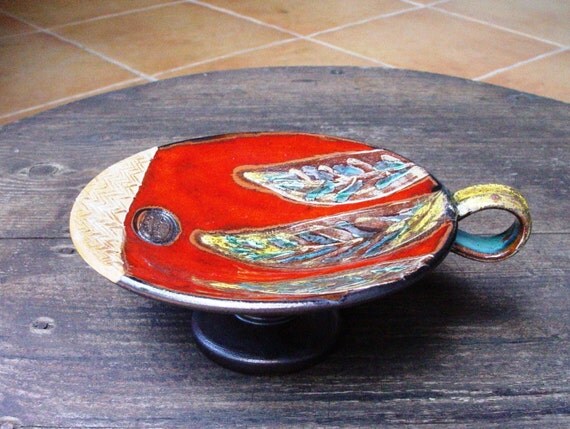
Pottery Candle holder, Candle Stick, Hand painted pottery.
Wheel thrown, hand glazed ceramic __candle holder.
Measuring 5.7in/15cm wide by 2.3in/6cm high.
Similar items:
https://www.etsy.com/listing/229894701/ceramic-candle-holder-pottery-candle?ref=shop_home_active_1
https://www.etsy.com/listing/234627095/pottery-candle-holder-ceramics-and?ref=shop_home_active_3
https://www.etsy.com/listing/239242571/unique-handmade-pottery-candle-holder?ref=related-3
Ceramics, which is one of the first industrial activities of man, has artistic qualities, and is considered art even in its initial development.
The numerous tribes and peoples, that lived in the lands where Bulgaria is, have left their rich cultural heritage. Through the ages the region has gathered different types of ceramics of Thracians, Romans, Slavs and Proto-Bulgarians. The proximity to the Mediterranean and its rich and diverse culture has influenced the development of Bulgarian crafts.
In DankoHandmade we embrace tradition by interpreting it in a modern way. Each of our product lines has its own style and character, but all of them carry the comfort and warmth of Bulgarian land.
The Process:
(Explore our shop for other stages of ceramics making)
FIRING
Firing clay transforms it from its humble, soft beginnings into a new substance, ceramics. Ceramics are tough, strong, and very similar in some ways to stone. Pieces of pottery have survived for thousands of years, all due to clay that met fire.
Firing is the process of bringing clay and glazes up to a high temperature. The final aim is to heat the object to the point that the clay and glazes are “mature” – that is, that they have reached their optimal level of melting. (Pots and other clay objects won’t look melted; their melting is on the molecular level.)
Bisque firing is the first time the pots go through high temperature heating. It is done in order to vitrify the clay pots enough that they won’t be harmed when glazes are applied, but not vitrified to such an extent that the glaze won’t adhere correctly.
Once glazes have been applied to the bisqueware and have had a chance to dry, the ware is carefully loaded into the kiln for the glaze firing. Pots cannot be allowed to touch at all, or the glazes will melt together, welding the pots together.
The kiln is heated slowly to the proper temperature to bring the clay and glazes to maturity, and then slowly cooled again. Only after the kiln has cooled will it be opened and unloaded.
Wheel thrown, hand glazed ceramic __candle holder.
Measuring 5.7in/15cm wide by 2.3in/6cm high.
Similar items:
https://www.etsy.com/listing/229894701/ceramic-candle-holder-pottery-candle?ref=shop_home_active_1
https://www.etsy.com/listing/234627095/pottery-candle-holder-ceramics-and?ref=shop_home_active_3
https://www.etsy.com/listing/239242571/unique-handmade-pottery-candle-holder?ref=related-3
Ceramics, which is one of the first industrial activities of man, has artistic qualities, and is considered art even in its initial development.
The numerous tribes and peoples, that lived in the lands where Bulgaria is, have left their rich cultural heritage. Through the ages the region has gathered different types of ceramics of Thracians, Romans, Slavs and Proto-Bulgarians. The proximity to the Mediterranean and its rich and diverse culture has influenced the development of Bulgarian crafts.
In DankoHandmade we embrace tradition by interpreting it in a modern way. Each of our product lines has its own style and character, but all of them carry the comfort and warmth of Bulgarian land.
The Process:
(Explore our shop for other stages of ceramics making)
FIRING
Firing clay transforms it from its humble, soft beginnings into a new substance, ceramics. Ceramics are tough, strong, and very similar in some ways to stone. Pieces of pottery have survived for thousands of years, all due to clay that met fire.
Firing is the process of bringing clay and glazes up to a high temperature. The final aim is to heat the object to the point that the clay and glazes are “mature” – that is, that they have reached their optimal level of melting. (Pots and other clay objects won’t look melted; their melting is on the molecular level.)
Bisque firing is the first time the pots go through high temperature heating. It is done in order to vitrify the clay pots enough that they won’t be harmed when glazes are applied, but not vitrified to such an extent that the glaze won’t adhere correctly.
Once glazes have been applied to the bisqueware and have had a chance to dry, the ware is carefully loaded into the kiln for the glaze firing. Pots cannot be allowed to touch at all, or the glazes will melt together, welding the pots together.
The kiln is heated slowly to the proper temperature to bring the clay and glazes to maturity, and then slowly cooled again. Only after the kiln has cooled will it be opened and unloaded.